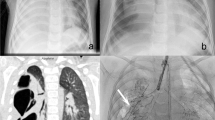Abstract
The present article describes two cases of bronchopleural fistula (BPF) occurring after radiofrequency ablation of lung tumors. Both procedures were carried out using expandable multitined electrodes, with no coagulation of the needle track. After both ablations, ground-glass opacities encompassed the nodules and abutted the visceral pleura. The first patient had a delayed pneumothorax, and the second had a recurrent pneumothorax. Both cases of BPF were diagnosed on follow-up computed tomography chest scans (i.e., visibility of a distinct channel between the lung or a peripheral bronchus and the pleura) and were successfully treated with chest tubes alone. Our goal is to highlight the fact that BPF can occur without needle-track coagulation and to suggest that minimally invasive treatment is sufficient to cure BPFs of this specific origin.


Similar content being viewed by others
References
Sano Y, Kanazawa S, Gobara H et al (2007) Feasibility of percutaneous radiofrequency ablation for intrathoracic malignancies: a large single-center experience. Cancer 109:1397–1405
Yamagami T, Kato T, Hirota T et al (2006) Pneumothorax as a complication of percutaneous radiofrequency ablation for lung neoplasms. J Vasc Interv Radiol 17:1625–1629
Okuma T, Matsuoka T, Yamamoto A et al (2008) Frequency and risk factors of various complications after computed tomography-guided radiofrequency ablation of lung tumors. Cardiovasc Interv Radiol 31:122–130
de Baère T, Palussière J, Aupérin A et al (2006) Midterm local efficacy and survival after radiofrequency ablation of lung tumors with minimum follow-up of 1 year: prospective evaluation. Radiology 240:587–596
Hiraki T, Tajiri N, Mimura H et al (2006) Pneumothorax, pleural effusion, and chest tube placement after radiofrequency ablation of lung tumors: incidence and risk factors. Radiology 241:275–283
Nour-Eldin NE, Naguib NN, Saeed AS et al (2009) Risk factors involved in the development of pneumothorax during radiofrequency ablation of lung neoplasms. AJR Am J Roentgenol 193:W43–W48
Gillams AR, Lees WR (2007) Analysis of the factors associated with radiofrequency ablation-induced pneumothorax. Clin Radiol 62:639–644
Yoshimatsu R, Yamagami T, Terayama K et al (2009) Delayed and recurrent pneumothorax after radiofrequency ablation of lung tumors. Chest 135:1002–1009
Sakurai J, Hiraki T, Mukai T et al (2007) Intractable pneumothorax due to bronchopleural fistula after radiofrequency ablation of lung tumors. J Vasc Interv Radiol 18:141–145
Clasen S, Kettenbach J, Kosan B et al (2009) Delayed development of pneumothorax after pulmonary radiofrequency ablation. Cardiovasc Interv Radiol 32:484–490
Jin GY, Han YM, Lee YS et al (2008) Radiofrequency ablation using a monopolar wet electrode for the treatment of inoperable non-small cell lung cancer: a preliminary report. Korean J Radiol 9:140–147
Lois M, Noppen M (2005) Bronchopleural fistulas: an overview of the problem with special focus on endoscopic management. Chest 128:3955–3965
Hataji O, Yamakado K, Nakatsuka A et al (2005) Radiological and pathological correlation of lung malignant tumors treated with percutaneous radiofrequency ablation. Intern Med 44:865–869
Ricci ZJ, Haramati LB, Rosenbaum AT et al (2002) Role of computed tomography in guiding the management of peripheral bronchopleural fistula. J Thorac Imaging 17:214–218
Yamamoto A, Nakamura K, Matsuoka T et al (2005) Radiofrequency ablation in a porcine lung model: correlation between CT and histopathologic findings. AJR Am J Roentgenol 185:1299–1306
Steinke K, King J, Glenn D et al (2003) Radiologic appearance and complications of percutaneous computed tomography-guided radiofrequency-ablated pulmonary metastases from colorectal carcinoma. J Comput Assist Tomogr 27:750–757
Baumann MH, Strange C, Heffner JE et al (2001) AACP Pneumothorax Consensus Group. Management of spontaneous pneumothorax: an American College of Chest Physicians Delphi consensus statement. Chest 119:590–602
Acknowledgment
We thank Pippa McKelvie-Sebileau and Jane Coulter for their help with the manuscript.
Author information
Authors and Affiliations
Corresponding author
Rights and permissions
About this article
Cite this article
Cannella, M., Cornelis, F., Descat, E. et al. Bronchopleural Fistula After Radiofrequency Ablation of Lung Tumours. Cardiovasc Intervent Radiol 34 (Suppl 2), 171–174 (2011). https://doi.org/10.1007/s00270-010-9826-x
Received:
Accepted:
Published:
Issue Date:
DOI: https://doi.org/10.1007/s00270-010-9826-x




